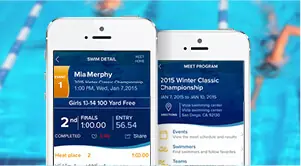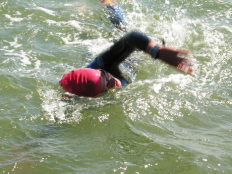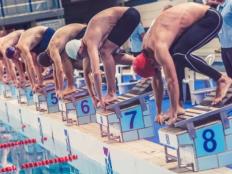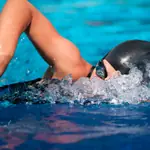Your goggles get knocked off.
2 of 7
With the amount of traffic at the race start and near the buoys, it will almost certainly happen. Having your goggles knocked off your eyes or head can completely dismantle your swim. An easy trick to avoid losing your goggles or having them shift on your face if bumped is to wear the strap underneath your cap rather than over it. Be sure the cap doesn't cover much more than your hairline on your face, so as not to put any pressure on the goggles themselves, potentially breaking the air tight seal they're meant to create.
And if it does happen? Stay calm, move out of the way of other swimmers, and try to keep your heart rate low while you slide your goggles back on. Don't rush, because if you don't get them on tightly, you'll likely have to stop again later. If you need to, hang on the side of a kayak for extra stability while you slip them back onto your head.
Find More:
Your Next TriathlonThe water is unexpectedly choppy.
3 of 7
When you get to the beach on race day, spend a few minutes on the shore observing the surrounding area and various landmarks. Looking at the swim course, pick large or fixed objects on land that will be in the line of sight of the buoys, as well as the finish chute on the course. This way, when sighting, you're able to reference the large landmark, especially when your visibility of the buoy is covered by a wave or other swimmers.
With sighting, it's best to sight with a low profile and often. Practicing these mechanics in the pool will allow sighting to ingrain into your stroke like second nature. Sight every two to three stroke cycles to guarantee a straight line. When your sighting visibility is obscured by waves or other swimmers, do not hesitate—continue your stroke cycle and sight the following stroke to paint the rest of the picture that you missed.
Find More:
Your Next TriathlonYour goggles keep fogging up.
4 of 7
Goggles fog for one main reason—your hands! When you wipe the inside of the lenses to try to clean them off or de-fog them, the oils on your fingers can break down the anti-fog coating. In addition, goggles can fog due to the difference in temperature of your face and the water; plus, they do have a shelf life, especially when worn often in the rough, coarse saltwater. To help extend their life, rinse them with cold water after a swim and dry them with a soft towel. Beyond this, picking up anti-fog spray or wipes will prove invaluable on race day, giving you confidence that your lenses will pave a clear path to the finish.
Find More:
Your Next TriathlonThe water is really cold, and there's no warmup in the water.
5 of 7
Acclimating to the cold takes time, along with a heavy dose of patience. If you know you'll be racing in a chillier climate, it is smart to begin training in cold conditions long before the race. However, there are race scenarios when the weather is throwing a fit, and it is significantly colder on race morning than expected.
If warming up in the water isn't an option, you still need to warm up your body and raise your heart rate before you toe the line. Go for an easy 10-minute jog, finishing just before your wave start. This will create some internal heat—just enough to look forward to some "refreshing" water and dull the initial shock of the temperature.
When the gun goes off, rather than sprinting into the water and being shocked by the temperature, walk in slowly to gradually acclimate and allow your breath to adjust more easily. Focus exclusively on relaxing your breath with a smooth inhale, followed by a relaxed sighing exhale. For the first few hundred yards, try to remain exclusively focused on your breath; in your head say, "inhale, exhale, inhale, exhale." Going through this mantra will help block out all other noise and negative self-talk that can become a distraction.
Find More:
Your Next TriathlonThe course is too long and you're desperate to finish.
6 of 7
It's nearly impossible to measure and standardize distances in the open water because, well, water doesn't sit still very well. When you find yourself slogging away in a race, wondering when the finish will come, shift your focus. Counting your strokes can help you stay tuned in on the quality of your stroke while blocking out any negative self-talk that otherwise would send you into a downward spiral. Try counting 10 easy strokes, then 10 moderate effort strokes and finally, 10 hard effort strokes. Next count to nine strokes at a time, then eight and so on. Staying fully focused on your stroke will get you through the swim without the concern of whether you can do it or the internal nagging of how much further you have to go.
Find More:
Your Next TriathlonThe race isn't wetsuit legal—and you assumed it would be.
7 of 7
Wearing a legal flotation device is pretty cushy, huh? Your approach should be that wearing a suit is simply a bonus when the race allows for one. And when it doesn't? Well that's just normal swimming for you. Train without a wetsuit to learn how to best engage your entire body and maintain proper posture from head to toe in the water. This also means that you'll be maximizing your power and speed, and more confident when your wetsuit has to stay in your bag.
Find More:
Your Next TriathlonGet ACTIVE on the Go


Meet Mobile
Swim smarter: heats, lane assignments and real-time results in the palm of your hand.
Available for iOS | Android





Discuss This Article